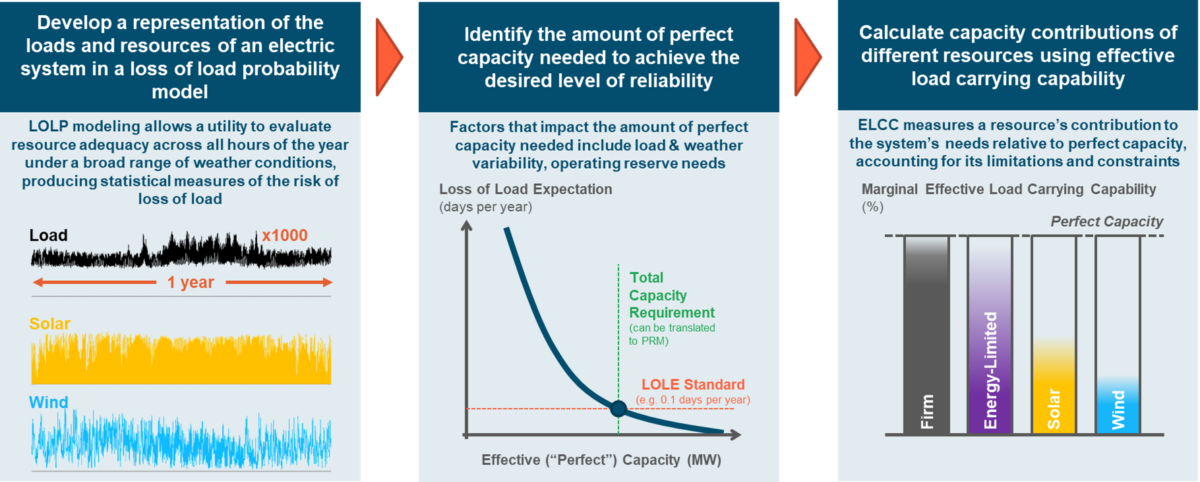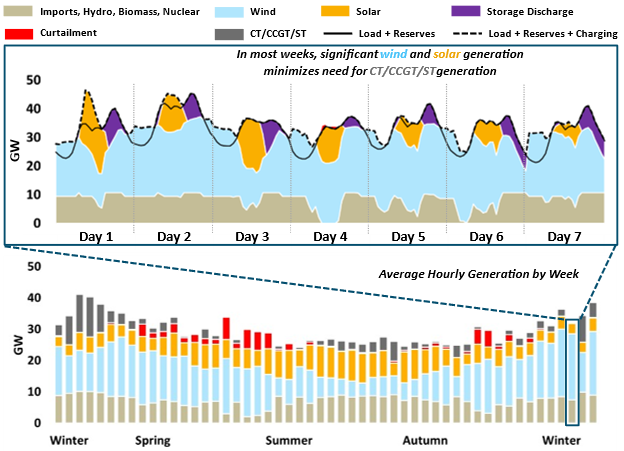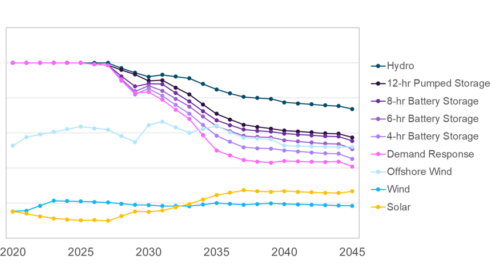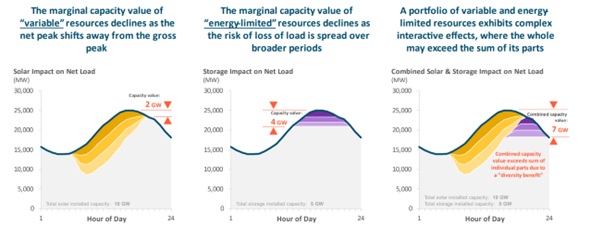E3’s Renewable Energy Capacity Planning Model (RECAP) is a loss-of-load-probability model designed to evaluate the resource adequacy of electric power systems, including systems with high penetrations of renewable energy and other dispatch-limited resources such as hydropower, energy storage, and demand response. RECAP was initially developed for the California Independent System Operator (CAISO) in 2011 to facilitate studies of renewable integration and has since been adapted for use across North America.
Historically, resource adequacy planning focused on meeting the peak demand hours (e.g., summer peak hours) using resources that could be assumed to have random, uncorrelated outages. In this world, simple accounting approaches were adequate for determining total system need and accrediting individual resources. As the penetration of variable renewable and dispatch-limited resources grows, new techniques are needed that consider the weather-dependent nature of renewable energy production, duration limitations on resources such as energy storage and demand response, and energy limitations over multi-day renewable drought events.
RECAP evaluates resource adequacy through time-sequential simulations of thousands of years of plausible system conditions to calculate statistically significant system reliability metrics and individual resource contributions to system reliability, capturing correlations among weather, load, and renewable generation. RECAP also introduces stochastic forced outages of thermal plants and transmission assets and time-sequentially tracks hydro, demand response, and storage state of charge.

Key Steps to a Reliability Planning Framework
E3 has used RECAP to support utilities, regulators, developers, and ISOs across North America, evaluating topics like the future of reliability planning, resource capacity valuation, capacity market design, emerging technology evaluation, and climate resilience. Projects include:
Hawaiian Electric Resource Adequacy Workplan (2022-Ongoing). E3 was retained by Hawaiian Electric to assess and evaluate a future reliability planning framework for Hawaiian Electric’s power system. To complete this resource adequacy workplan, as directed by the Hawaiian PUC, E3 will complete a comparison analysis between 3 reliability frameworks: hourly energy reserve margin (ERM) and hourly dependable capacity (HDC), hourly energy reserve margin (ERM) and hourly expected capacity (HEC), annual planning reserve margin (PRM) and effective load carrying capability (ELCC) framework.
Resource Adequacy in the Desert Southwest (2021-2022). E3 was retained by a group of utilities to assess resource adequacy in the Desert Southwest. The analysis informed several key findings, namely: (1) load growth and resource retirements are creating a significant and urgent need for new resources in the Southwest region; (2) the region’s utilities have identified sufficient new resources in their integrated resource plans to close the gap; and (3) solar and storage resources will make up an increasingly significant share of long-term resource needs, but the region’s existing firm resources will still be needed to maintain reliability.
Net Zero New England, Long Run Resource Adequacy Under Deep Decarbonization (2020). E3 performed a study to assess electricity sector resource adequacy requirements under long-term economy-wide decarbonization in the New England states (MA, CT, RI, NH, VT, ME). E3 completed this work in conjunction with Ernest Moniz’s Energy Futures Initiative (EFI) and a regional stakeholder advisory group. Using our economy-wide decarbonization scenario model (PATHWAYS), E3 studied economy-wide decarbonization up to net zero carbon which resulted in a significant quantity of building, vehicle, and industrial electrification as well as 95% direct emission reductions in the electricity sector. Using our in-house electricity capacity expansion model (RESOLVE) and reliability model (RECAP), E3 determined that achieving electricity sector decarbonization while meeting additional load growth from electrification requires a significant build-out of solar, wind (onshore and offshore), battery storage, and additional firm generating capacity to maintain acceptable reliability during periods of low wind and solar generation.

Asset Developer ELCC Forecasting. E3 has supported and continues to support resource developers and utilities in forecasting resource capacity value in markets across North America. E3 uses RECAP to calculate portfolio ELCC and ELCCs marginal to existing power systems. ELCC is used increasingly in organized capacity markets across North America for accreditation of variable and dispatch-limited resources. E3 provides custom forecasts of changing ELCC values over time for each of the major organized markets in North America.

Illustrative ELCC forecast
California Energy Commission, Assessing the Value of Long Duration Storage (2020-ongoing). E3 was awarded an EPIC grant by the California Energy Commission (CEC) to investigate the role of long duration energy storage in achieving California’s energy and climate goals. This study will (1) develop a clearer understanding of the tradeoffs between energy storage duration, performance, and cost against a range of other emerging energy technologies (including but not limited to carbon capture & storage, low-carbon fuels, and advanced nuclear); (2) develop an updated, publicly available dataset to characterize potential futures for California’s grid; and (3) develop a new modeling toolkit to extend California’s capabilities to plan for a deeply decarbonization electricity sector that appropriately values emerging technologies like long duration storage.

Capturing Resource Interactive Effects in ELCCs
All Tools


